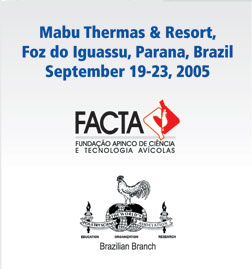LONG SAGE (SERIAL ANALYSIS OF GENE EXPRESSION) IN
Eimeria TENELLA – A PRELIMINARY STUDY
J.
Novaes1, L. Varuzza1; L.T. Nagao1, T.J.P. Sobreira1,
A.Y. Kashiwabara2, C.A.B. Pereira2, A.M. Durham2,
A. Gruber1 and A.M.B.N. Madeira1,*
1Faculty of Veterinary Medicine and Zootechny, 2Institute
of Mathematics and Statistics, University of São
Paulo, Brazil
*albackx@usp.br
Eimeria tenella
is one of the most relevant causing agent of poultry
coccidiosis. Since this species is amenable to laboratory
manipulation, including in vitro cell culture and
transfection, it became the model species for coccidiosis
research. Genome and EST sequencing projects are underway
in several laboratories throughout the world, including
ours. Identification of the complete set of transcripts
expressed in a genome is essential for genome annotation
and gene function studies. Another central topic to
better understand the biology of the parasite is the
transcriptome expression level and, most important,
the differential gene expression. In order to address
this point, we decided to perform serial analysis
of gene expression (SAGE) on second-generation merozoites
and sporozoites, both representing invasive developmental
stages of the parasite. In this work, we employed
the long SAGE method, a modified protocol that generates
21-bp tags, thus allowing a better tag mapping than
the conventional SAGE. We have obtained so far a total
of 8,096 tags (3,457 unique tags) from a merozoite-derived
library. Analysis of individual tag abundance showed
that 2,464 tags (30%) occurred only once, 425 tags
occurred 2 times (10%), 206 tags 3 times (8%), 322
tags repeat from 4 to 20 times (30%), 29 tags from
21 to 36 times (10%) and 11 tags from 38 to 186 times
(12%). These results suggest that a very small number
of genes is highly expressed. In another preliminary
analysis, the 3,457 unique tags were mapped onto the
E. tenella genome sequence. From this set, 46.6% (1,612
tags) did not present any hit on the genome. A frequency
distribution of the unique tags presenting genome
hits revealed that 85% (1,561 tags) mapped to a single
site, 12% (218 tags) to two sites, whereas 3% (66
tags) mapped to multiple sites. We intend to map the
tags on EST clusters in order to improve the corresponding
gene assignment. We are now constructing other SAGE
libraries from sporozoite and merozoite mRNAs, whose
tags will be incorporated into the study. Statistical
modeling and analysis will be used to evaluate the
differential gene expression.
Financial
support: FAPESP, CNPq, CAPES and Pró-Reitoria
de Pesquisa USP
